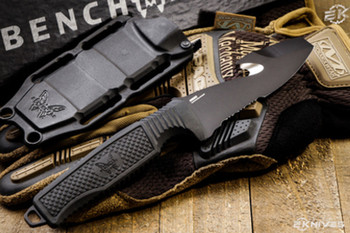Finding the Best Diving Knife: What You Should Consider
Posted by Clayton on Oct 6th 2015
One of the biggest questions novice divers ask is “Do I really need to have a dive knife?” The answer is a resounding “YES!” You will not find one experienced diver roaming the deep blue without a trusty dive knife strapped to one leg. The reason is simple: always be prepared. You’re already navigating unfamiliar territory, where getting entangled in line, having thick kelp caught in your dive gear, or experiencing unexpected danger are all real possibilities.
Don’t get caught in a worst case scenario hundreds of feet below the surface. Always bring a custom dive knife with you.
The 3 Top Reasons You Need a Dive Knife
- Cut through line. Unfortunately, this can be a more common occurrence than one would think, and it is the number one reason you need a dive knife. If you get caught in monofilament cords or lines, your only way out will be with a dive knife. Getting caught in this trap can cause serious injury to you, cause you to damage or lose your equipment, and, in extreme cases, lead to death. With a dive knife you’ll be able to cut through cords, lines, and sea kelp, allowing you to free yourself and avoid a seriously dangerous situation.
- Shark attack. The chances you’ll encounter a shark that you’ll have to fight off are slim. If you’re close enough to stab one, it’s probably too late anyway. However, defending yourself is better than doing nothing. You’ll need at least a Spyderco H1 Pacific Salt for a fighting chance. Using a Shark Shield may be more effective.
- Free sea creatures. You are far more likely to need to save marine life than fend off a shark attack while diving. Unfortunately, the oceans are hazardous to all kinds of marine life, due to human behavior. Six pack soda can rings, abandoned nets, and snarled fishing line are among the debris that present a danger to underwater life. You can be the hero and right a wrong by cutting away the offending waste and freeing them.
Choose the Right Dive Knife for You: The Material and Size
There are five main factors you need to consider when choosing a dive knife: material, size, blade type, blade shape, and the attachment that keeps the blade secure to your body. When it comes to the material, most modern knives appropriate for diving are made from stainless steel, steel alloys, or titanium. They’re strong, rugged, and slow to rust – especially titanium.
Steel knives will require more maintenance, as they can rust more easily, but you can choose between two different alloys: 300 or 400. The 400 alloy is easier to rust, but holds its edge better and is easy to sharpen. The 300 alloy is slightly harder to sharpen than the 400, as it is closer to titanium, but on the plus side it doesn’t rust as easily as the 400, requiring less maintenance on your part. Still, after each dive, wash and buff dry your knives, and spray them with silicone lubricant before storing.
If you choose a custom titanium knife, you get the benefits of an extremely strong knife that doesn’t corrode, but, similar to the 300 alloy, it will be harder to sharpen. Choosing the material and size best suited to you is based on your use. If you are simply a recreational diver that only plans to use it if you accidently get tangled, a small 3” to 4” blade will suit your needs just fine. If you plan on using it to cut fouled lines, assist in spearfishing, or kelp dive, go with a 5” blade or longer.
Choose Your Blade Wisely: Type and Shape
You can choose from out the front (OTF), folding, or fixed blade knives. You may carry a folder or OTF for cutting away entanglements, or a rugged fixed blade for heavy cutting, prying, or stabbing. Foldable blades are smaller, lighter, and easier to stow, but lack the one hand grab in a tricky situation. Divers often carry fixed blades in sheaths for the one hand grabs. OTF blades like the Microtec Troodon Blue DE Combo dagger-style, partially serrated 3” blade are slender and work well with one hand.
When it comes to the shape of your dive knife, you need to look at the tip and edge. A good dive knife is both straight and serrated, as both edges are needed. The straight blade is good for cutting nylon rope and plastic, while the serrated edge is perfect for kelp and similar textures. It’s best to go with a blunt tip, as it works better for digging, hacking, and chiseling.
In contrast, if you intend to use your knife for spearfishing, a sharp tip is best to puncture and cut the fish, or free a spear point. Strap a Marifone Custom Interceptor Hollow Handle to your leg and be a real underwater badass. Keep in mind, pointed tip knives are more dangerous, so if you’re a recreational diver, go with the blunt tip.

